The sweet cherry variety "Iput" adored by many gardeners
Cherry Iput has been successfully grown in the gardens of our country for many years. The variety was bred specifically for the climatic conditions of Central Russia and is famous for its unpretentious nature and yield. However, there are some nuances in growing it, which we will discuss in detail in the article.
The content of the article
What is this variety of cherry
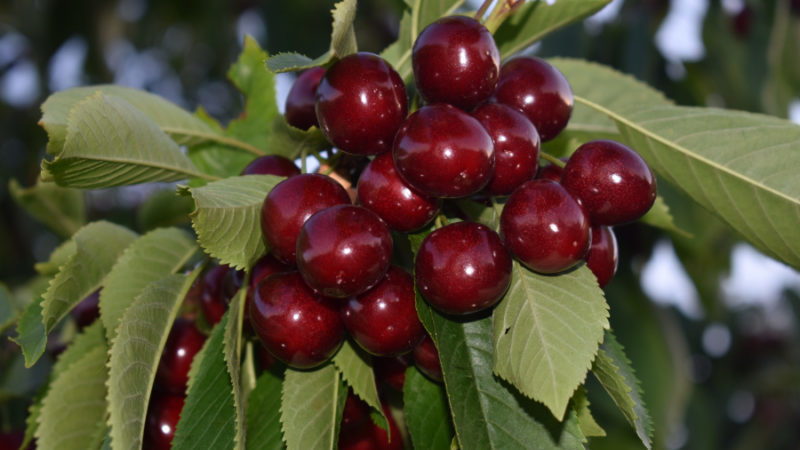
Iput -winter hardy and a partially self-fertile crop of average yield. Refers to early early fertile varieties.
Brief history of origin and distribution
The authors of the variety are M.V. Kanshina and A.I. Astakhov. They continued the experiment of the famous breeder I. Michurin to breed frost-resistant varieties of fruit trees.
Iput was brought out in Bryansk on the basis of the All-Russian Research Institute of Lupin in the late 80s, and in 1993 it was entered into the state register. Most often, this variety is found in the gardens of the Central and Central Black Earth regions.
Characteristics and description of trees
Cherry Iput is a fruit tree with a pyramidal crown and dense dark green foliage. An adult tree reaches an average height of 3.5 m, some specimens - 4.5-5 m. The bark of the tree is reddish-brown, thin.
The flowers are composed of white petals touching each other. There are usually 3-4 of them in the inflorescence. The tree begins to bear fruit after the fourth year of life.
Resistant to temperatures
Frost resistance is one of the main advantages of this variety. Trees can tolerate temperatures down to -30 ° C without harm. But thaws followed by a sharp cold snap are dangerous. After above-zero temperatures, frosts down to -20 ° C can destroy the plant.
There is no need to cover trees for the winter, but some gardeners insulate young seedlings during severe frosts, wrapping them with special covering materials, for example, spunbond.
Moisture and drought resistance
Iput is drought-resistant, watered no more than once a week. An excess of moisture has a bad effect primarily on the harvest - the berries begin to crack.
Disease and pest resistance
This variety has a strong immunity to pests and diseases. However, in conditions of high humidity or after incorrect pruning, fungal diseases can appear (read about them below). Of the pests, aphids are the most dangerous.
Characteristics and description of berries
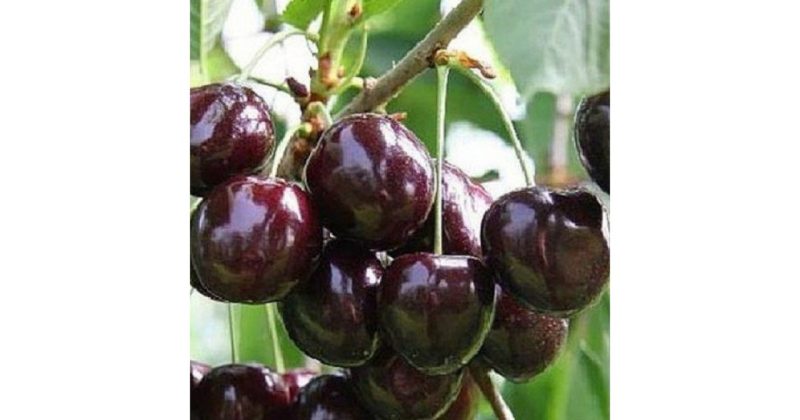
Cherry fruits Iput are large, rounded, with a dense dark red skin. The pulp is juicy, sweet, with a slightly bitter aftertaste and brightly colored juice.
The stone is small, it is difficult to separate from the pulp. Connoisseurs give her a tasting score of 4.5 points out of five.
Areas of their application
The variety is versatile, so the berries can be eaten both fresh and processed. Compotes, jams and preserves are cooked from the fruits.
Due to the high content of vitamin C (about 17% of the daily value in 100 g), Iput is useful. Blanks from it are very relevant in the winter, when fighting colds.
Advantages and disadvantages of the variety
Benefits:
- frost and winter hardiness;
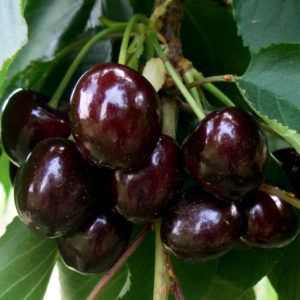
- regular annual yield;
- early ripening (end of June);
- resistance to diseases and pests;
- trees are not tall, which makes harvesting easier;
- sweet and juicy fruits;
- versatility of use.
Disadvantages:
- trees begin to bear fruit after 4 years of cultivation:
- with an excess of moisture, the fruits crack;
- the bone is difficult to separate from the pulp.
Growing technology
First of all, it is important to choose high-quality seedlings for landing... They should be with proportionally developed roots and branches, without signs of diseases or traces of their treatment. The bark of a good seedling is firm, smooth, with a rich brown hue.
Optimal conditions
The Iput variety should not be chosen for regions where the air temperature drops below -30 ° C in winter. The most acceptable climatic conditions of the southern and middle zone. It rarely happens here with a thaw with a sharp cold snap.
Iput should not be planted in lowlands and places where stagnant melt or rain water occurs. The soil should be fertile, with a medium acidity level. It is best to prepare your landing site in advance. For this, the soil is mixed with compost and a small amount of superphosphate.
Terms and rules of landing
It is recommended to plant Iput cherries in early spring or autumn until the end of September. Experienced gardeners often do this in April, when there is no longer any threat of frost. The seedling has time to prepare for wintering and takes root properly.
The plot is chosen sunny, with well-drained soil. It is desirable that the tree be in the sun for at least six hours, this guarantees a good harvest and sweetness of the fruit.
Drainage is required, since with constant contact with water, the roots of the tree are not able to absorb nutrients. If the soil has a high clay content, it is sprinkled with sand.
Planting sequence:
- The site is dug up and planting pits are prepared, about 0.5 m deep, twice as wide. They are guided by the size of the root system - the pit should be slightly larger than it.
- A bucket of rotted manure is mixed with soil in the ratio of a third of organic matter and two-thirds of soil.
- The seedling is placed in the center of the planting pit with the roots spread out. They are pre-soaked in water for about two hours, and then dipped in a clay mash to prevent contact with soil fungi. Chatterbox - a solution of clay and water with the consistency of thick sour cream.
- A tying peg is placed next to the tree to give stability.
- The pit is covered with earth, moving from the edge to the center. The earth is tamped down a little. In the middle of the process, 1-2 buckets of water are poured in.
- The soil is evenly distributed around the cherry.
It is important to take into account the plants adjacent to the Iput cherry. It is best to settle other varieties of cherries nearby, for example, Tyutchevka, Revna, or cherry - this contributes to good pollination. Black elderberry will protect planting from aphids. Grapes grow well nearby. Sweet cherries are loved by flowers such as daffodils, primrose and tulips.
Don't expect a good harvest with neighbors like potatoes and tomatoes. They do not like the neighborhood with this cherry variety of apple, pear and plum.
Further care
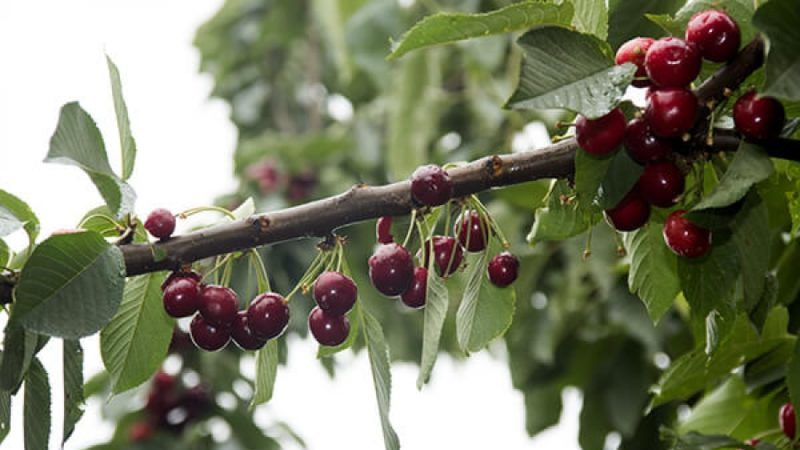
The near-trunk area is regularly cleared of overgrowth and weeds. It is important to follow the watering schedule: 1-2 times a month, and in case of severe drought - every week. Such a schedule is relevant from the moment of vegetation until the end of August.
From the second year of planting, the trees are cut off, forming a sparse-tiered crown. In the first five years, cherries form long growths, they are cut off, leaving no more than 50 cm.
An adult plant is pruned to thin the crown and rejuvenate the tree... Remove branches that grow inward and form sharp corners. During fruiting, diseased and broken shoots are removed.
To obtain a rich harvest, the trees are regularly fed. Fertilize at the root in spring and autumn. This can be ammonium nitrate, urea-based mineral solution, chicken droppings or a layer of peat, humus and compost. In the summer, special attention is paid to foliar feeding. Solutions that contain potassium and phosphorus are suitable.
Important. When feeding, you can not use mineral and organic fertilizers at the same time.
Whitewashing is done twice a year. In the fall, this is done to protect the tree from overheating the trunk in winter. Wood does not transmit heat well, therefore, heating up during the day, it does not have time to cool down by the evening. A sharp temperature drop can lead to the formation of frost cracks in the barrel.
The second time the tree is whitewashed in early spring to protect it from pests that have waited out the cold in the soil and can now climb the trunk.
Possible problems, diseases, pests
There are several diseases that can cause severe damage to cherries.
- Rust. It manifests itself as brown spots on the leaves, which causes them to dry out and fall off. In order to prevent the trees before flowering, they are treated with the "HOM" preparation, and after harvesting, they are re-treated with Bordeaux liquid. All affected shoots must be cut and burned.
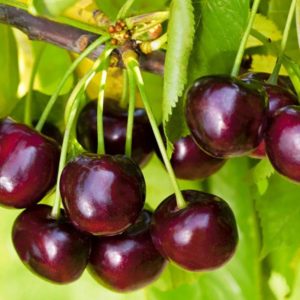
- Clasteroporosis. When a tree is affected by this disease, brown spots appear on the leaves, which subsequently form holes. Due to clotteroporosis, the shape of the fruit changes. The affected leaves are cut off and burned, and the cherries are treated with copper-containing preparations.
- Coccomycosis. Iput has a strong immunity to this disease, but the proximity to other varieties of cherries and cherries increases the risk of possible damage. With coccomycosis, purple spots appear on the leaves. To avoid infection, gardeners, twice a season, before flowering and after harvesting, treat cherries with Bordeaux liquid or copper oxychloride.
In addition to bacterial and viral diseases, cherries are also threatened by some pests. The most dangerous are cherry aphids and cherry weevils.
The problem is solved with the help of insecticides "Decis" and "B-58" or they turn to folk methods in the form of a soap solution (300 g per 10 liters of water) and an infusion of wormwood (half a bucket of grass and half a bucket of water are insisted for a day, boiled for 30 minutes, filtered and added water 1: 1).
Attention. 1.5 months before harvesting, treatment with pesticides is not recommended.
The appearance of woodworms and bark beetles will help prevent phosphorus fertilizers. They will protect you from bears, golds and beetles.
Subject to the rules of tree care, for example, without disrupting the irrigation and fertilization schedule, Iput cherries do not bring problems.
Wintering
To prevent the negative effects of low temperatures, the trunk of a young sweet cherry is covered with whitewash and wrapped with burlap or roofing felt.
If there are severe frosts in the region, the crown is covered with light lutrasil.
Reproduction
Cherry Iput is a partially self-fertile variety. For a good harvest, it is artificially pollinated or planted with other representatives of the species. You can use a cherry as a neighbor, given the coincidence in flowering time.
Features of cultivation depending on the region
In the southern regions, the Iput variety pleases with a rich harvest due to the comfortable weather conditions. The basic rule for its cultivation is timely watering during drought periods and regular preventive measures to combat pests.
Due to its frost resistance, Iput feels comfortable in the gardens of the Leningrad Region and the Volga region. The main thing is to provide trees with a comfortable wintering.
Pollinating varieties
Sweet cherry:
- Tyutchevka;
- Jealous;
- Ovstuzhenka;
- Raditsa;
- Bryansk pink.
Cherry:
- Putinka;
- Podbelskaya;
- English early.
Reviews of summer residents
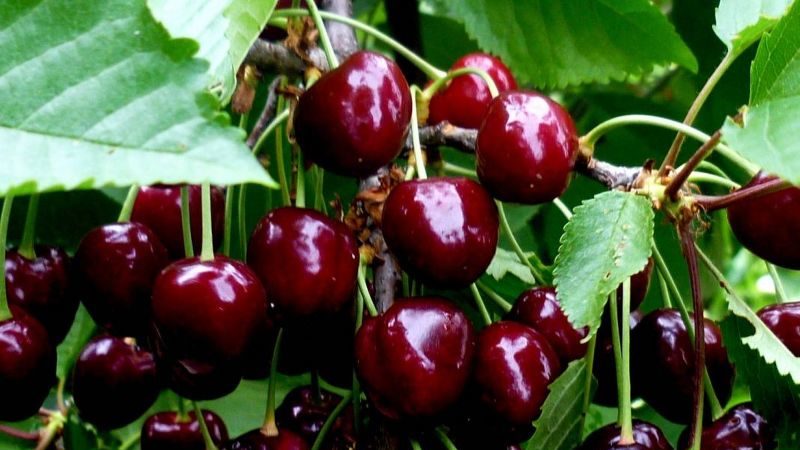
Summer residents most often speak positively about the variety, noting frost resistance and taste.
Olga I., Stavropol: "Iput cherries have been growing on my site for ten years. I really like the taste of the berries, they make an excellent compote ”.
Semyon V., Kursk: “I got the Iput along with the purchase of the garden plot. The previous owner took good care of the trees, we try to keep them at the same level. They endure winter without problems, they are not afraid even of severe frosts, the yield is decent. "
Victor S., Ivanov: “For the first experience of growing sweet cherry I chose Iput. The choice was made on the recommendation of a friend, an experienced gardener. I was pleased with the unpretentiousness of the seedlings, planted four pieces. Everybody got down to it and overwintered successfully. "
Conclusion
Unpretentious care and frost resistance are the main advantages of Iput cherries. They allow this southern plant to be grown even in the regions. with cold winters... It is enough to provide optimal conditions for growth, and the tree will please with a good harvest.